Solar PV Supply Chain Market Forecast
- Global solar PV supply chain market size to reach US$318.3 Bn in 2030, up from US$125.8 Bn attained in 2022
- Market valuation projected to witness a CAGR of 12.3% between 2023 and 2030
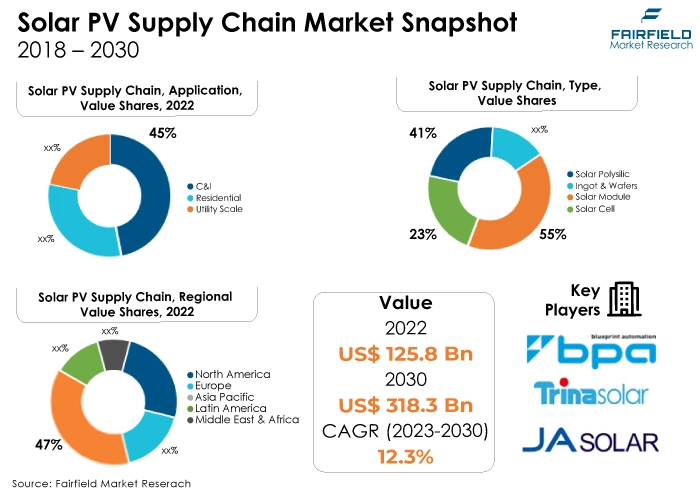
Quick Report Digest
- The key trend anticipated to fuel the solar PV supply chain market growth is the rising demand for renewable energy sources and government programs encouraging solar adoption.
- Another major market trend expected to fuel the solar PV supply chain market growth is the quickening pace of technological development in solar PV components, particularly in solar cells and inverters, which has increased supply chain efficiency and reduced costs.
- In 2022, the solar cell category dominated the industry. The decreasing costs of solar panels enhance price competitiveness and accelerate solar adoption across residential, commercial, and industrial sectors.
- In terms of market share for the solar PV supply chain globally, the residential segment is anticipated to dominate. Due to the convergence of several important elements, residential solar PV is positioned to become the dominant segment in the solar PV supply chain. Homeowners have embraced solar power mostly due to increased awareness of climate change and the significance of sustainable energy alternatives.
- In 2022, cost-saving economies of scale and ongoing technology improvements have greatly lowered the price of solar PV componentry. The cost-effectiveness of solar energy has increased its appeal, promoting a wider acceptance and accelerating market growth across numerous industries and geographical areas.
- The growing footprint of solar PV adoption in developing nations reveals significant unmet prospects. These markets have enormous growth potential because of their rising urbanisation, rising energy demand, and desire to diversify their energy sources. Solar photovoltaic technology emerges as a key solution, offering a favourable environment for market penetration and growth, as these regions prioritize energy security and sustainable development.
- In order to increase price competitiveness and hasten the adoption of solar energy in the residential, commercial, and industrial sectors, the paper examines cost dynamics within the solar PV supply chain, focusing on the falling costs of solar panels.
- The solar PV supply chain market in North America is observing an upward trend in business purchases of renewable energy. Due to appealing power purchase agreements (PPAs), many corporations are investing in large-scale solar installations to achieve sustainability goals. Energy storage integration is also becoming more popular as utilities look to improve grid stability and take into account intermittent renewable energy sources.
A Look Back and a Look Forward - Comparative Analysis
The market for solar PV supply chains is expanding significantly as a result of rising global demand for sustainable energy and initiatives to cut carbon emissions. The market's present growth is mostly a result of technological progress, cost savings, and benevolent government initiatives. Manufacturers of solar panels, inverters, mounting systems, and raw material suppliers are significant participants in the solar PV supply chain.
The market witnessed staggered growth during the historical period 2018 - 2022, driven by governmental incentives, scientific discoveries, and growing public concern about climate change. During the early stages, there were noticeable difficulties due to high manufacturing costs and very low efficiency. The solar PV supply chain has expanded globally over time, sourcing raw materials and components from a variety of places.
In the future, the solar PV supply chain may incorporate cutting-edge technology like perovskite solar cells, bifacial panels, and energy storage systems. Production costs should decrease as a result of increased automation and AI-driven manufacturing processes. The circular economy and sustainability will likely be highlighted by the solar PV sector, with a focus on recycling and reusing solar panels and component waste.
Improved eco-design guidelines will promote the creation of more environmentally responsible and sustainable solar goods. It is anticipated that the solar PV supply chain will continue to expand as a result of falling solar energy costs, favourable policy conditions, and developing energy storage technologies.
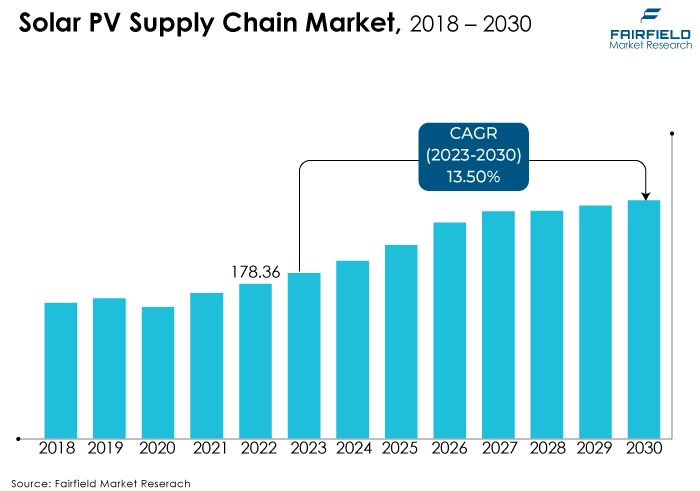
Key Growth Determinants
- Cost Reduction, and Technological Advancements
The solar PV supply chain market is expanding because of cost reduction and technology developments. The cost of solar PV components has dramatically decreased over time, revolutionizing the solar industry and bringing solar energy closer to parity with other energy sources. This decrease is the consequence of improved manufacturing techniques, economies of scale, and higher production efficiency for solar cells and modules.
The performance and efficiency of solar panels have also been greatly enhanced by ongoing technological developments in photovoltaic materials, cell designs, and energy storage devices. Thin-film solar cells, perovskite solar cells, and bifacial modules are just a few of the innovations that have shown significant promise in increasing energy production and lowering cost per watt.
Solar PV is becoming a more appealing and practical alternative for a larger range of applications as prices continue to drop and efficiency rises, which is further boosting the development of the solar PV supply chain market.
- Technological Integration, and Digitalisation
Digitalisation and technological integration are crucial factors in the development of the solar PV supply chain market. The efficiency, monitoring, and maintenance of solar PV systems are optimised through the integration of cutting-edge technologies including the Internet of Things (IoT), Artificial Intelligence (AI), machine learning, and blockchain. IoT makes it possible to gather and analyse data in real-time from solar panels and other components, enabling proactive maintenance and performance improvement.
By improving energy forecasting, grid management, and defect detection, AI and machine learning algorithms maximize the overall performance of solar installations. Blockchain technology also makes transparent and safe transactions possible, making it easier to track the generation, distribution, and use of solar energy. The solar PV supply chain is made more efficient, more cost-effective, and more reliable thanks to the seamless integration of various technologies, which supports long-term expansion.
- Urbanisation, and Industrialisation
The demand for solar PV solutions is mostly driven by urbanisation and industrialisation. The need for dependable and sustainable energy sources rises as metropolitan areas grow and industrial activity levels rise. Due to their scalability, adaptability to urban environments, and compliance with industrial power needs, solar PV systems are well-suited to address this growing demand.
Due to the high concentration of energy consumers brought on by urbanisation, solar PV systems on parking lots, rooftops, and other urban areas are quite feasible. Industrialisation also requires a lot of energy for operations, and solar PV offers a clean, affordable way to meet these needs while also supporting corporate sustainability objectives.
Urbanisation, industrialisation, and solar PV all coexist in a symbiotic connection, highlighting the crucial role that solar energy plays in powering our cities and industries responsibly.
Major Growth Barriers
- Supply Chain Disruptions
In the solar PV sector, supply chain disruptions are defined as unanticipated occurrences or conditions that prevent resources, components, and goods from moving smoothly through the supply chain. These interruptions may be caused by a variety of events, including as natural catastrophes like earthquakes, hurricanes, or floods, as well as geopolitical tensions, trade disputes, or even global health crises.
Delays, shortages, higher prices, and a breakdown in production plans may result from such interruptions. The inability to meet deadlines and complete orders by manufacturers, distributors, and installers may delay projects, which eventually prevents the development and use of solar PV technology. Strong contingency planning, supplier and logistics diversification, as well as efficient risk management tactics, are required to minimize these interruptions.
- Quality Control and Standards Compliance
For a product to be reliable and accepted by the market, it must adhere to established standards, such as those developed by groups like the International Electrotechnical Commission (IEC) or Underwriters Laboratories (UL). Failure to comply can lead to product recalls, harm to one's brand, problems with the law, and even risks end users.
To satisfy these criteria, suppliers and manufacturers make major investments in quality control, fostering trust in the solar PV sector and encouraging sustainable growth.
Key Trends and Opportunities to Look at
- Circular Economy and Recycling
An increasing focus on sustainability and circular economy principles is driving the demand for recycling and reusing end-of-life solar PV components. Within the supply chain, the development of effective recycling technology offers a huge potential to minimize waste and maximize resource utilisation.
- Electrification and Green Hydrogen
The push for electrification in numerous industries, along with the growth of solar-powered electrolysis to produce green hydrogen, present substantial prospects for the solar PV supply chain. The creation of green hydrogen from solar electricity can be a crucial source, easing the transition to a low-carbon economy.
- Emerging Markets and Rural Electrification
Emerging markets provide numerous opportunities, notably for off-grid solar products that can give remote and underprivileged communities access to energy. Rural electrification initiatives open a need for distributed solar PV systems and the supply chain growth that goes along with them.
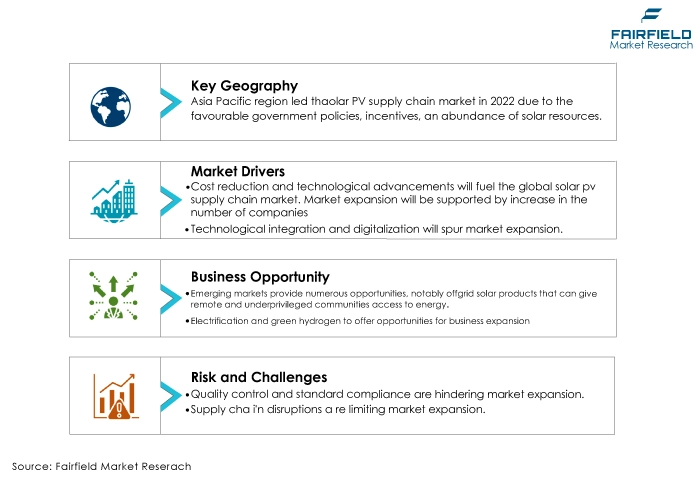
How Does the Regulatory Scenario Shape this Industry?
The regulatory environment significantly influences the solar PV supply chain market. Government policies and regulations can facilitate a healthy solar PV market, or it might be hampered. Supportive regulations, such as those that provide incentives, subsidies, and mandates for renewable energy sources, promote investment in solar projects and increase demand for solar PV components. These regulations foster the growth of the supply chain by attracting investors and establishing a stable market environment.
The solar PV supply chain, on the other hand, may be disrupted by regulatory issues like shifting subsidy packages or inconsistent rules. Regulation ambiguity can dissuade investment and make it challenging for firms to plan and carry out projects successfully. Therefore, for the solar PV supply chain market to grow sustainably and continue to play a significant part in the world's transition to renewable energy, a stable and favourable regulatory framework is necessary.
Fairfield’s Ranking Board
Top Segments
- Solar Cell Category Dominant over Solar Polysilicon Segments
The solar PV supply chain market is dominated by solar cells. With the quick development and widespread production of solar cell technologies, particularly monocrystalline and polycrystalline silicon cells, the ascendancy started in the early months of 2002. The higher efficiency and durability of these technologies led to a spike in demand for solar panels.
The dominance of the solar cell market is fuelled by a few key factors, including ongoing technological advancements that result in higher efficiencies, significant cost reductions brought on by economies of scale and improvements in manufacturing, growing public awareness of the advantages of renewable energy and combating climate change, favourable government policies and incentives that promote solar adoption, and a growing emphasis on sustainability.
Furthermore, the solar polysilicon category is projected to experience the fastest market growth. As countries and industries strive to shift towards renewable energy sources to mitigate climate change and achieve sustainability goals, the demand for solar PV systems has soared, consequently boosting the need for polysilicon.
- Residential Solar PV to Lead
Residential solar PV is poised to be the leading segment in the solar PV supply chain, driven by a convergence of key factors. First and foremost, heightened awareness of climate change and the importance of sustainable energy solutions have propelled homeowners to embrace solar power.
With solar PV systems on rooftops, residential properties can generate their own clean, renewable energy, reducing their reliance on fossil fuels and contributing to a greener environment.
Furthermore, C&I is the fastest-growing segment during the forecast period. The declining costs of solar panels and associated technologies make solar PV financially viable for C&I entities, offering a significant reduction in long-term operational costs.
Additionally, advancements in financing models and incentives, along with favourable policies, further catalyze this growth by providing accessible avenues for C&I companies to invest in solar installations.
Regional Frontrunners
Asia Pacific - the Largest Revenue Contributor
Asia Pacific area contributes the most revenue to the worldwide solar PV supply chain market. Solar PV manufacturing, installation, and invention have been concentrated in the Asia Pacific region, particularly in China, India, Japan, South Korea, and Australia. These nations have made large expenditures in manufacturing facilities, research and development, and solar energy infrastructure, which has fuelled the expansion of the solar PV supply chain. Particularly in the production and export of solar PV, China has dominated the market.
Furthermore, North America is the fastest-growing region during the forecast period. Several factors underscore this robust growth. The area has witnessed a significant surge in solar PV installations, driven by an increasing focus on renewable energy and sustainability. Governments and businesses in North America are setting ambitious renewable energy targets, offering incentives, subsidies, and tax benefits that encourage solar PV adoption, thereby accelerating market growth.
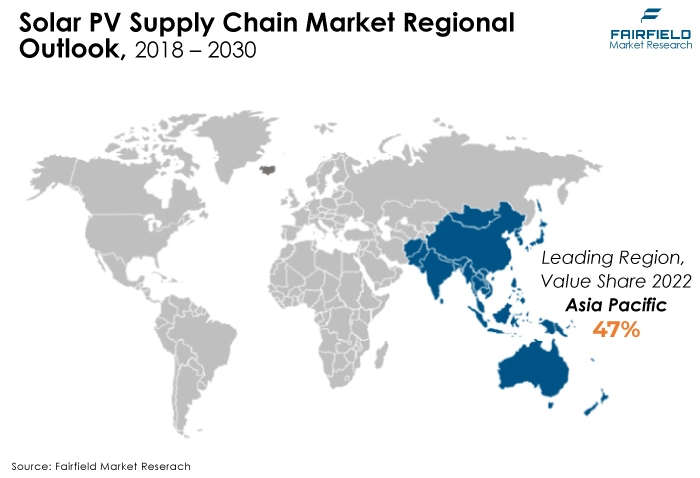
North America Set for Significant Growth
The growth of North America region is due to a number of reasons that influenced the rise. First, the adoption of solar energy has been boosted by pro-solar government regulations and incentives at the federal, state, and local levels such as investment tax credits (ITC), and renewable portfolio standards (RPS).
Moreover, businesses and individuals are making investments in solar PV systems due to a growing focus on sustainability and lowering carbon emissions. The development of solar PV in North America is also being accelerated by advances in solar technology, falling solar installation costs, and growing public awareness of the advantages of renewable energy.
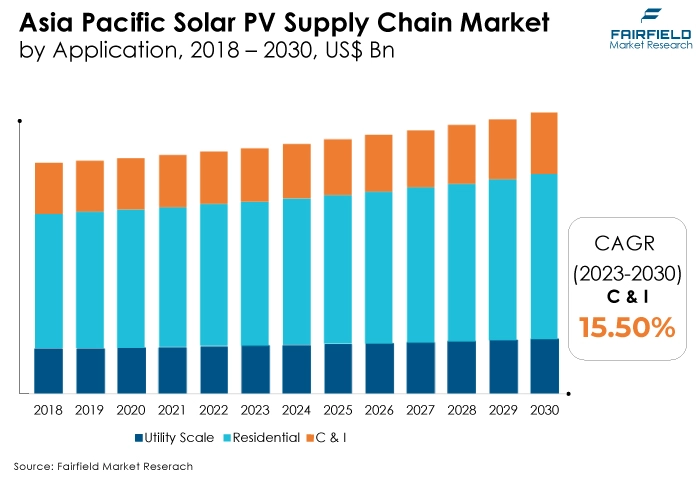
Fairfield’s Competitive Landscape Analysis
The solar PV supply chain market is a consolidated market with fewer major players present across the globe. The key players are introducing new products as well as working on the distribution channels to enhance their worldwide presence. Moreover, Fairfield Market Research is expecting the market to witness more consolidation over the coming years.
Who are the Leaders in Global Solar PV Supply Chain Space?
- JinkoSolar Holding Co. Ltd.
- Trina Solar Limited
- Canadian Solar Inc.
- First Solar Inc.
- LONGi Green Energy Technology Co. Ltd.
- Hanwha Q CELLS Co. Ltd.
- A. Solar Holdings Co. Ltd.
- Risen Energy Co. Ltd.
- SunPower Corporation
- REC Silicon ASA
- LG Chem Ltd. A.
- Enphase Energy Inc.
- SMA Solar Technology AG
- ABB Group
- Huawei Technologies Co. Ltd.
Significant Company Developments
New Product Launches
- April 2022: First Solar declared that its cutting-edge thin-film solar modules, which achieved 15.9% total area efficiency, broke the previous record for cadmium-telluride (CdTe) photovoltaic (P.V.) module efficiency.
- September 2020: According to JinkoSolar, independent testing conducted on its high-efficiency Tiger Pro Series modules resulted in a maximum output of up to 580Wp. In addition, Bloomberg New Energy Finance (BNEF) named JinkoSolar as one of the best solar brands in these financially challenging times.
- October 2020: The UNO-DM-PLUS solar inverters from ABB Group were made available in the U.S. market; they provide a more adaptable and effective option for home solar installations.
Distribution Agreements
- May 2021: Beijing Trina Solar Energy Co., Ltd No. Jifan Gao, CEO, or Arturo Herrero, Director, Sales and Marketing, each with the sole power of representation, are the representatives for 2 Xin Yuan Yi Road, Electronics Park, New District, Changzhou, Jiangsu, Zipcode 213031, China, an organisation and entity existing under Chinese law.
- February 2020: IBC-SOLAR AG, Am Hochgericht 10, 96231 Bad Staffelstein, Germany, a company incorporated and existing under German law, is represented by either Christian Lieberth, the purchasing manager, or by CEO Udo Möhrstedt, each of whom has exclusive representational authority.
An Expert’s Eye
Demand and Future Growth
As per Fairfield’s Analysis, Solar cells dominate the solar PV supply chain industry. Early in 2002, the ascendancy began because of the swift advancement and mass production of solar cell technologies, particularly monocrystalline and polycrystalline silicon cells. Solar panel demand increased because of these technologies' better efficiency and sturdiness.
Several key factors contribute to the dominance of the solar cell market, including ongoing technological advancements that lead to higher efficiencies, significant cost reductions brought on by economies of scale and improvements in manufacturing, growing public awareness of the benefits of renewable energy and addressing climate change, favourable government policies and incentives that promote solar adoption, and a growing focus on sustainability.
Supply Side of the Market
According to our analysis, the solar PV supply chain has seen China as a dominant force for many years. It contributes significantly to the world's manufacturing capacity and is a major producer of solar cells and panels. Taiwan, a significant participant in the solar PV supply chain that is renowned for producing high-quality solar cells and cutting-edge technology, is another. Several renowned solar panel producers and suppliers of essential components are in South Korea.
Silicon is a key component of solar cell manufacturing, and it is found in silicon wafers. High-purity silicon ingots are cut into silicon wafers, which are the form it takes. Solar cells are typically made from crystalline silicon wafers. Thin-film solar cells, for example, use different raw materials like cadmium telluride (CdTe) or copper indium gallium selenide (CIGS).
Chinese companies like GCL-Poly and Daqo New Energy are major suppliers of polysilicon, which is a significant country producer. Major suppliers of solar cells and modules include well-known Chinese businesses like JinkoSolar, Canadian Solar, and Trina Solar.
Solar PV Supply Chain Market is Segmented as Below:
By Type:
- Solar Polysilicon
- Ingot and Wafer
- Solar Cell
- Solar Module
By Application:
- Utility Scale
- C&I
- Residential
By Geographic Coverage:
- North America
- The U.S.
- Canada
- Europe
- Germany
- U.K.
- France
- Italy
- Turkey
- Russia
- Rest of Europe
- Asia Pacific
- China
- Japan
- South Korea
- India
- Southeast Asia
- Rest of Asia Pacific
- Latin America
- Brazil
- Mexico
- Argentina
- Rest of Latin America
- Middle East & Africa
- GCC
- South Africa
- Egypt
- Nigeria
- Rest of the Middle East & Africa
1. Executive Summary
1.1. Global Solar PV Supply Chain Market Snapshot
1.2. Future Projections
1.3. Key Market Trends
1.4. Regional Snapshot, by Value, 2022
1.5. Analyst Recommendations
2. Market Overview
2.1. Market Definitions and Segmentations
2.2. Market Dynamics
2.2.1. Drivers
2.2.2. Restraints
2.2.3. Market Opportunities
2.3. Value Chain Analysis
2.4. Porter’s Five Forces Analysis
2.5. COVID-19 Impact Analysis
2.5.1. Supply
2.5.2. Demand
2.6. Impact of Ukraine-Russia Conflict
2.7. Economic Overview
2.7.1. World Economic Projections
2.8. PESTLE Analysis
3. Global Solar PV Supply Chain Market Outlook, 2018 - 2030
3.1. Global Solar PV Supply Chain Market Outlook, by Type, Value (US$ Mn), 2018 - 2030
3.1.1. Key Highlights
3.1.1.1. Solar Polysilicon
3.1.1.2. Ingot and Wafer
3.1.1.3. Solar Cell
3.1.1.4. Solar Module
3.2. Global Solar PV Supply Chain Market Outlook, by Application, Value (US$ Mn), 2018 - 2030
3.2.1. Key Highlights
3.2.1.1. Utility Scale
3.2.1.2. C&I
3.2.1.3. Residential
3.3. Global Solar PV Supply Chain Market Outlook, by Region, Value (US$ Mn), 2018 - 2030
3.3.1. Key Highlights
3.3.1.1. North America
3.3.1.2. Europe
3.3.1.3. Asia Pacific
3.3.1.4. Latin America
3.3.1.5. Middle East & Africa
4. North America Solar PV Supply Chain Market Outlook, 2018 - 2030
4.1. North America Solar PV Supply Chain Market Outlook, by Type, Value (US$ Mn), 2018 - 2030
4.1.1. Key Highlights
4.1.1.1. Solar Polysilicon
4.1.1.2. Ingot and Wafer
4.1.1.3. Solar Cell
4.1.1.4. Solar Module
4.2. North America Solar PV Supply Chain Market Outlook, by Application, Value (US$ Mn), 2018 - 2030
4.2.1. Key Highlights
4.2.1.1. Utility Scale
4.2.1.2. C&I
4.2.1.3. Residential
4.3. North America Solar PV Supply Chain Market Outlook, by Country, Value (US$ Mn), 2018 - 2030
4.3.1. Key Highlights
4.3.1.1. U.S. Solar PV Supply Chain Market by Type, Value (US$ Mn), 2018 - 2030
4.3.1.2. U.S. Solar PV Supply Chain Market Application, Value (US$ Mn), 2018 - 2030
4.3.1.3. Canada Solar PV Supply Chain Market by Type, Value (US$ Mn), 2018 - 2030
4.3.1.4. Canada Solar PV Supply Chain Market Application, Value (US$ Mn), 2018 - 2030
4.3.2. BPS Analysis/Market Attractiveness Analysis
5. Europe Solar PV Supply Chain Market Outlook, 2018 - 2030
5.1. Europe Solar PV Supply Chain Market Outlook, by Type, Value (US$ Mn), 2018 - 2030
5.1.1. Key Highlights
5.1.1.1. Solar Polysilicon
5.1.1.2. Ingot and Wafer
5.1.1.3. Solar Cell
5.1.1.4. Solar Module
5.2. Europe Solar PV Supply Chain Market Outlook, by Application, Value (US$ Mn), 2018 - 2030
5.2.1. Key Highlights
5.2.1.1. Utility Scale
5.2.1.2. C&I
5.2.1.3. Residential
5.2.2. BPS Analysis/Market Attractiveness Analysis
5.3. Europe Solar PV Supply Chain Market Outlook, by Country, Value (US$ Mn), 2018 - 2030
5.3.1. Key Highlights
5.3.1.1. Germany Solar PV Supply Chain Market by Type, Value (US$ Mn), 2018 - 2030
5.3.1.2. Germany Solar PV Supply Chain Market Application, Value (US$ Mn), 2018 - 2030
5.3.1.3. U.K. Solar PV Supply Chain Market by Type, Value (US$ Mn), 2018 - 2030
5.3.1.4. U.K. Solar PV Supply Chain Market Application, Value (US$ Mn), 2018 - 2030
5.3.1.5. France Solar PV Supply Chain Market by Type, Value (US$ Mn), 2018 - 2030
5.3.1.6. France Solar PV Supply Chain Market Application, Value (US$ Mn), 2018 - 2030
5.3.1.7. Italy Solar PV Supply Chain Market by Type, Value (US$ Mn), 2018 - 2030
5.3.1.8. Italy Solar PV Supply Chain Market Application, Value (US$ Mn), 2018 - 2030
5.3.1.9. Turkey Solar PV Supply Chain Market by Type, Value (US$ Mn), 2018 - 2030
5.3.1.10. Turkey Solar PV Supply Chain Market Application, Value (US$ Mn), 2018 - 2030
5.3.1.11. Russia Solar PV Supply Chain Market by Type, Value (US$ Mn), 2018 - 2030
5.3.1.12. Russia Solar PV Supply Chain Market Application, Value (US$ Mn), 2018 - 2030
5.3.1.13. Rest of Europe Solar PV Supply Chain Market by Type, Value (US$ Mn), 2018 - 2030
5.3.1.14. Rest of Europe Solar PV Supply Chain Market Application, Value (US$ Mn), 2018 - 2030
5.3.2. BPS Analysis/Market Attractiveness Analysis
6. Asia Pacific Solar PV Supply Chain Market Outlook, 2018 - 2030
6.1. Asia Pacific Solar PV Supply Chain Market Outlook, by Type, Value (US$ Mn), 2018 - 2030
6.1.1. Key Highlights
6.1.1.1. Solar Polysilicon
6.1.1.2. Ingot and Wafer
6.1.1.3. Solar Cell
6.1.1.4. Solar Module
6.2. Asia Pacific Solar PV Supply Chain Market Outlook, by Application, Value (US$ Mn), 2018 - 2030
6.2.1. Key Highlights
6.2.1.1. Utility Scale
6.2.1.2. C&I
6.2.1.3. Residential
6.2.2. BPS Analysis/Market Attractiveness Analysis
6.3. Asia Pacific Solar PV Supply Chain Market Outlook, by Country, Value (US$ Mn), 2018 - 2030
6.3.1. Key Highlights
6.3.1.1. China Solar PV Supply Chain Market by Type, Value (US$ Mn), 2018 - 2030
6.3.1.2. China Solar PV Supply Chain Market Application, Value (US$ Mn), 2018 - 2030
6.3.1.3. Japan Solar PV Supply Chain Market by Type, Value (US$ Mn), 2018 - 2030
6.3.1.4. Japan Solar PV Supply Chain Market Application, Value (US$ Mn), 2018 - 2030
6.3.1.5. South Korea Solar PV Supply Chain Market by Type, Value (US$ Mn), 2018 - 2030
6.3.1.6. South Korea Solar PV Supply Chain Market Application, Value (US$ Mn), 2018 - 2030
6.3.1.7. India Solar PV Supply Chain Market by Type, Value (US$ Mn), 2018 - 2030
6.3.1.8. India Solar PV Supply Chain Market Application, Value (US$ Mn), 2018 - 2030
6.3.1.9. Southeast Asia Solar PV Supply Chain Market by Type, Value (US$ Mn), 2018 - 2030
6.3.1.10. Southeast Asia Solar PV Supply Chain Market Application, Value (US$ Mn), 2018 - 2030
6.3.1.11. Rest of Asia Pacific Solar PV Supply Chain Market by Type, Value (US$ Mn), 2018 - 2030
6.3.1.12. Rest of Asia Pacific Solar PV Supply Chain Market Application, Value (US$ Mn), 2018 - 2030
6.3.2. BPS Analysis/Market Attractiveness Analysis
7. Latin America Solar PV Supply Chain Market Outlook, 2018 - 2030
7.1. Latin America Solar PV Supply Chain Market Outlook, by Type, Value (US$ Mn), 2018 - 2030
7.1.1. Key Highlights
7.1.1.1. Solar Polysilicon
7.1.1.2. Ingot and Wafer
7.1.1.3. Solar Cell
7.1.1.4. Solar Module
7.2. Latin America Solar PV Supply Chain Market Outlook, by Application, Value (US$ Mn), 2018 - 2030
7.2.1. Key Highlights
7.2.1.1. Utility Scale
7.2.1.2. C&I
7.2.1.3. Residential
7.2.2. BPS Analysis/Market Attractiveness Analysis
7.3. Latin America Solar PV Supply Chain Market Outlook, by Country, Value (US$ Mn), 2018 - 2030
7.3.1. Key Highlights
7.3.1.1. Brazil Solar PV Supply Chain Market by Type, Value (US$ Mn), 2018 - 2030
7.3.1.2. Brazil Solar PV Supply Chain Market Application, Value (US$ Mn), 2018 - 2030
7.3.1.3. Mexico Solar PV Supply Chain Market by Type, Value (US$ Mn), 2018 - 2030
7.3.1.4. Mexico Solar PV Supply Chain Market Application, Value (US$ Mn), 2018 - 2030
7.3.1.5. Argentina Solar PV Supply Chain Market by Type, Value (US$ Mn), 2018 - 2030
7.3.1.6. Argentina Solar PV Supply Chain Market Application, Value (US$ Mn), 2018 - 2030
7.3.1.7. Rest of Latin America Solar PV Supply Chain Market by Type, Value (US$ Mn), 2018 - 2030
7.3.1.8. Rest of Latin America Solar PV Supply Chain Market Application, Value (US$ Mn), 2018 - 2030
7.3.2. BPS Analysis/Market Attractiveness Analysis
8. Middle East & Africa Solar PV Supply Chain Market Outlook, 2018 - 2030
8.1. Middle East & Africa Solar PV Supply Chain Market Outlook, by Type, Value (US$ Mn), 2018 - 2030
8.1.1. Key Highlights
8.1.1.1. Solar Polysilicon
8.1.1.2. Ingot and Wafer
8.1.1.3. Solar Cell
8.1.1.4. Solar Module
8.2. Middle East & Africa Solar PV Supply Chain Market Outlook, by Application, Value (US$ Mn), 2018 - 2030
8.2.1. Key Highlights
8.2.1.1. Utility Scale
8.2.1.2. C&I
8.2.1.3. Residential
8.2.2. BPS Analysis/Market Attractiveness Analysis
8.3. Middle East & Africa Solar PV Supply Chain Market Outlook, by Country, Value (US$ Mn), 2018 - 2030
8.3.1. Key Highlights
8.3.1.1. GCC Solar PV Supply Chain Market by Type, Value (US$ Mn), 2018 - 2030
8.3.1.2. GCC Solar PV Supply Chain Market Application, Value (US$ Mn), 2018 - 2030
8.3.1.3. South Africa Solar PV Supply Chain Market by Type, Value (US$ Mn), 2018 - 2030
8.3.1.4. South Africa Solar PV Supply Chain Market Application, Value (US$ Mn), 2018 - 2030
8.3.1.5. Egypt Solar PV Supply Chain Market by Type, Value (US$ Mn), 2018 - 2030
8.3.1.6. Egypt Solar PV Supply Chain Market Application, Value (US$ Mn), 2018 - 2030
8.3.1.7. Nigeria Solar PV Supply Chain Market by Type, Value (US$ Mn), 2018 - 2030
8.3.1.8. Nigeria Solar PV Supply Chain Market Application, Value (US$ Mn), 2018 - 2030
8.3.1.9. Rest of Middle East & Africa Solar PV Supply Chain Market by Type, Value (US$ Mn), 2018 - 2030
8.3.1.10. Rest of Middle East & Africa Solar PV Supply Chain Market Application, Value (US$ Mn), 2018 - 2030
8.3.2. BPS Analysis/Market Attractiveness Analysis
9. Competitive Landscape
9.1. Capacity vs Application Heatmap
9.2. Manufacturer vs Application Heatmap
9.3. Company Market Share Analysis, 2022
9.4. Competitive Dashboard
9.5. Company Profiles
9.5.1. JinkoSolar Holding Co. Ltd.
9.5.1.1. Company Overview
9.5.1.2. Product Portfolio
9.5.1.3. Financial Overview
9.5.1.4. Business Strategies and Development
9.5.2. Trina Solar Limited
9.5.2.1. Company Overview
9.5.2.2. Product Portfolio
9.5.2.3. Financial Overview
9.5.2.4. Business Strategies and Development
9.5.3. Canadian Solar Inc.
9.5.3.1. Company Overview
9.5.3.2. Product Portfolio
9.5.3.3. Financial Overview
9.5.3.4. Business Strategies and Development
9.5.4. First Solar Inc.
9.5.4.1. Company Overview
9.5.4.2. Product Portfolio
9.5.4.3. Financial Overview
9.5.4.4. Business Strategies and Development
9.5.5. LONGI Green Energy Technology Co. Ltd.
9.5.5.1. Company Overview
9.5.5.2. Product Portfolio
9.5.5.3. Financial Overview
9.5.5.4. Business Strategies and Development
9.5.6. Hanwha Q CELLS CO. Ltd.
9.5.6.1. Company Overview
9.5.6.2. Product Portfolio
9.5.6.3. Financial Overview
9.5.6.4. Business Strategies and Development
9.5.7. JA Solar Holdings Co. Ltd.
9.5.7.1. Company Overview
9.5.7.2. Product Portfolio
9.5.7.3. Financial Overview
9.5.7.4. Business Strategies and Development
9.5.8. Risen Energy Co. Ltd.
9.5.8.1. Company Overview
9.5.8.2. Product Portfolio
9.5.8.3. Financial Overview
9.5.8.4. Business Strategies and Development
9.5.9. SunPower Corporation
9.5.9.1. Company Overview
9.5.9.2. Product Portfolio
9.5.9.3. Business Strategies and Development
9.5.10. REC Silicon ASA
9.5.10.1. Company Overview
9.5.10.2. Product Portfolio
9.5.10.3. Financial Overview
9.5.10.4. Business Strategies and Development
9.5.11. LG Chem Ltd.
9.5.11.1. Company Overview
9.5.11.2. Product Portfolio
9.5.11.3. Financial Overview
9.5.11.4. Business Strategies and Development
9.5.12. Enphase Energy Inc.
9.5.12.1. Company Overview
9.5.12.2. Product Portfolio
9.5.12.3. Financial Overview
9.5.12.4. Business Strategies and Development
9.5.13. SMA Solar Technology AG
9.5.13.1. Company Overview
9.5.13.2. Product Portfolio
9.5.13.3. Financial Overview
9.5.13.4. Business Strategies and Development
9.5.14. ABB Group
9.5.14.1. Company Overview
9.5.14.2. Product Portfolio
9.5.14.3. Financial Overview
9.5.14.4. Business Strategies and Development
9.5.15. Huawei Technologies Co. Ltd.
9.5.15.1. Company Overview
9.5.15.2. Product Portfolio
9.5.15.3. Financial Overview
9.5.15.4. Business Strategies and Development
10. Appendix
10.1. Research Methodology
10.2. Report Assumptions
10.3. Acronyms and Abbreviations
|
BASE YEAR |
HISTORICAL DATA |
FORECAST PERIOD |
UNITS |
|||
|
2022 |
|
2018 - 2022 |
2023 - 2030 |
Value: US$ Million |
||
|
REPORT FEATURES |
DETAILS |
|
Type Coverage |
|
|
Application Coverage |
|
|
Geographical Coverage |
|
|
Leading Companies |
|
|
Report Highlights |
Key Market Indicators, Macro-micro economic impact analysis, Technological Roadmap, Key Trends, Driver, Restraints, and Future Opportunities & Revenue Pockets, Porter’s 5 Forces Analysis, Historical Trend (2019-2021), Market Estimates and Forecast, Market Dynamics, Industry Trends, Competition Landscape, Category, Region, Country- wise Trends & Analysis, COVID-19 Impact Analysis (Demand and Supply Chain) |
